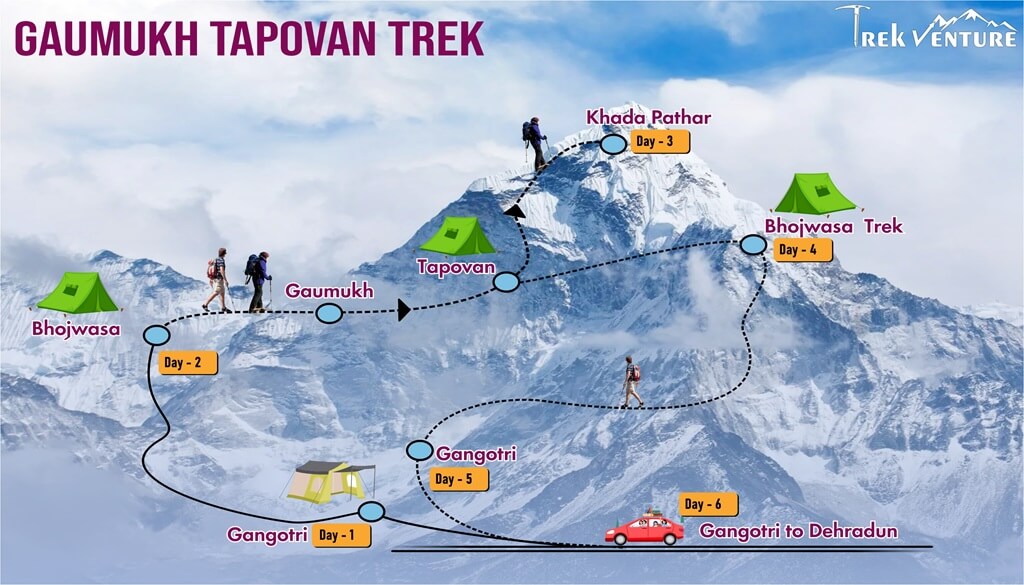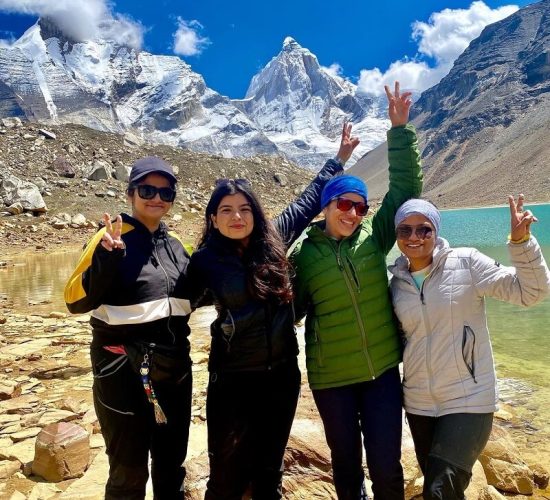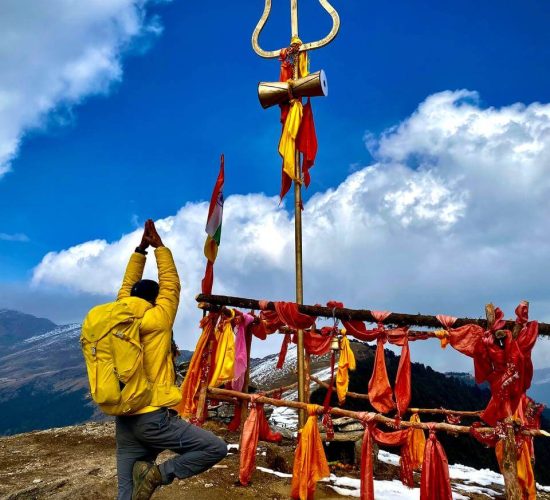Gaumukh Tapovan Trek
6D – 5N | Dehradun to Dehradun
Enquire for Group Booking
↬ Description
- Altitude : 14590 ft.
- Duration: 6 Days
- Trek Length: 46 kms
- Base Camp: Gangotri
The mesmerising Gaumukh Tapovan walk offers much more than that—it brings together fervour, spirituality, and adrenaline all in one single hike, which is a dangerous mix in and of itself. The trail passes through Gaumukh, which is the origin of the Ganga River, which can be seen gushing down the snout of the Gangotri glacier as you make your way through the region. Even while other neighbouring massifs such as the Bhagirathi twin peaks and Mt. Meru may be seen, the most captivating sight is the magnificent Mt. Shivling, which chaperones the whole walk, emerging little by bit every hour until it looms over you in its stark fullness, striking you speechless. This mountain is located in the Himalayas and is known for its imposing appearance. You will find another wonder waiting for you in the shape of the breathtaking meadow of Tapovan, which is positioned just above Gaumukh.
↬ Itinerary
Day 1: From Dehradun to Gangotri Drive
You should make plans to depart Dehradun by 6:00 am so that you may get the most out of your trip. Because the day will be longer, you will go to Gangotri by flying, which is 241 km away. It will be a trip through some of the most beautiful mountains that you will ever take, and it will last for eight hours. The well-known hill station of Mussorie, which is just 35 kilometres away from Dehradun, would be the primary attraction to begin with. The Shivalik Ranges may be seen in its entirety from the hill station. You will arrive at Uttarkashi, often known as the Land of the Gods, after making a brief stop in Dhanulti, Chamba, for lunch and to do some sight-seeing there. On the banks of the Bhagirathi River is where you’ll find Uttarkashi. You will be certain that you have arrived at the Land of the Gods after seeing all of the sacred temples and conversing with the holy people who live there. The lovely Harshil Village may be reached by following the Bhagirath River. The city of Harshil is famous for its apple orchards, which provide a welcome respite from the bustle of the city. In the heart of the mountains, Harshil is the place to go for a relaxing evening experience.
Day 2: Trek from Gangotri to Bhojwasa
When you finally do fall asleep, you will be greeted by awe-inspiring vistas of sun rays reflecting off of mountain peaks, and you will be eager to continue your journey. This will be a short walk lasting around two to three hours, with a gradual increase in elevation. At this point, the path opens out, providing you with a greater view of the Bhagirathi peaks. There will be sections of the landslip that are more suitable for walking on than others. After completing the hike, you will arrive to Bhojwassa, a level region that serves as the location for your overnight accommodations in tents. The region is rife with Bhopatra trees, which are more commonly known as birch trees. These trees were used in the production of the Bhojwasa. This is the most open and expansive area of the valley, and it offers the greatest view of Shivling Mountain. In addition to a number of residences designed in the form of igloos, there is also an ashram, a police station, and a rest house. These other options are open to you during your stay here today, but you will need permission to use them. After lunch, take some time to unwind at the campground, and then prepare to spend a night in the tents when it’s below freezing outside.
Day 3: Trek from Bhojwasa to Khada Pathar via Gaumukh & Tapovan
The time has come for the most difficult and lengthy journey up to this point; therefore, you should eat properly, bring energy bars, fill water bottles (there are no sources of water along the road), and fill your water bottles, and be ready to be delighted. From this point on, the hiking path ascends at a steeper angle and becomes more littered with rock boulders. The granite moraines on the glacier make the climb challenging, but they also eliminate the need for any specialised climbing gear. Make the climb less difficult by use a trekking pole. The last part of the journey to Tapovan is a rocky one, but after you’ve made it through it, you’ll be overjoyed to arrive at the well-known meadows, where you’ll be able to take in the splendour of Mount Shivling. Meditation is the primary purpose for why sadhus from all over the globe go to Tapovan. In addition to that, it is used as a base camp for hikes up Mount Shivling. Mount Shivling, widely recognised as one of the holiest and most magnificent mountains in the world, may be seen more clearly from this vantage point. The vistas of Mount Meru and the Bhagirathi peaks are breathtaking and should not be missed. After a strenuous climb, Tapovan is the ideal location to relax and unwind. It’s not uncommon to come across other mountain goats wandering about here, just like you. You should get back to your tent at the end of a long yet eventful day.
Day 4: From Tapovan, we descended to Bhojwasa Trek
The wee hours of the morning are the ideal time to make the most of the day’s waning hours while gazing at the sunlit majesty of the surrounding mountains. The magnificence of Mount Shivling has increased significantly, and it now dominates all of the other mountains in the area. They all come together to create a sight that is just breathtaking. After you’ve finished breakfast, it’s time to bring these recollections back to life. Because there are no other sources of water, you should continue to carry a meal and a lot of water in your backpack. You will, in fact, have to make another journey through the rocky terrain and moraines of the glacier. As you make your way around the boulders, you will realise that ascending is easier than descending, which presents a challenge for you. Watch what’s going on, and take things nice and easy. As you go back over what you just did, you should try to remember what happened. After reaching Gomukh after a difficult descent, you should continue with your stroll along the Bhagirathi River. Walking to Chirbassa will take anywhere between five and seven hours. After that, you’ll find yourself back among the previous pine trees. It should come as no surprise that you will be camping beside a river, in the midst of mountains, and under the shade of pine trees.
Day 5: Trek from Bhojwasa to Gangotri
As soon as you open your eyes, you’ll be reminded that this is the very final day of your journey. The journey to Gangotri is around 9 km long and can be completed in approximately 4-5 hours. At waterfalls and streams, water bottles should be replaced with fresh water. You won’t be able to see the Bhagirathi or any of the other high peaks for much longer, so say your farewell. At the guest home, you will be provided with a warm lunch as well as supper. Pack up your belongings and get ready to go back to Dehradun, where you will find your stunning new residences.
Day 6: Last Day. Gangotri to Dehradun
Drink one last cup of morning tea in the majestic country of Gangotri before leaving. Reminisce with your fellow hikers as you say your last goodbyes, trade contact information, and part ways. drive a great group shot before getting into the taxi that will drive you back to Dehradun, and then go ahead and enter the cab. The journey will take you for a total of eight hours and will take you through a variety of landscapes, including mountains, valleys, and the Bhagirathi River. Our journey was accompanied by a river the whole time. You will have arrived in Dehradun by 5 o’clock in the afternoon, and you will start your trip back according to the original schedule. Take back with you a tonne of exciting memories from your time in the mountains, and make a pact with yourself to come back here again soon.
↬ Map of Gaumukh Tapovan Trek

↬ Inclusion
- From Day 1 through Day 6 of your walk, you will be sleeping in various hotels and tents.
- All meals are provided, beginning with the first night’s dinner and ending with breakfast on day sixth. On all days of the walk, we provide simple, healthy vegetarian meals.
- We will provide for round-trip transportation from Dehradun to Dehradun
- Trekking permits and camping expenses in the woods are all accounted for.
- Tents and sleeping bags of the highest quality will be provided at each camp. Fortunately, we have high-altitude sleeping bags that are good down to ten degrees Celsius.
- Gaiters, microspikes, and ropes are available.
↬ Exclusion
- Costs associated with carrying personal items, such as luggage, on the hike.
- The term “emergency costs” refers to any and all costs that crop up as a direct consequence of a crisis.
- There will be no access to bottled water at any point throughout the walk.
↬ Things to carry

BASIC GEARS
- 45-60 ltrs trekking bag with rain cover and straps.
- 20-30 day pack with rain cover
- 2 water bottles. 1 normal and 1 milton/borrosil to keep warm water in night.
- Snacks energy bars, dry fruits, ors
- Personal medical kit as per your doctor.
CLOTHES
- 1 full fleece t-shirt
- tiffin box
- at least 3/4 full sleeves non cotton
- 1 fleece jacket woolen or sweater
- 1 down feather jacket/hollofil jacket
- Waterproof jacket/poncho
- Thermals inners (upper and lower)
- 1 pair 2 trek pants avoid shorts, fitting denim, and capris.
- 1 pair of waterproof gloves
- 1 pair of woolen gloves
- 1 head torch
- 1 sun cap
- 1 woolen cap
- 2 buff neck gaiter
- 1 sunglasses dark with a side cover should be UV protected.
- 1 pair of waterproof trekking shoes with high ankle and good grip
- 1 pair of floaters
- 4 pair of cotton socks
- 1 pair of woolen socks
- Sunscreen
- Hand sanitizer
- Dental kit
- Toilet paper and wet wipes
- Lip balm
- quick dry towel
- Moisturiser
- Antibacterial powder
↬ How to reach
By Air:
Jolly Grant Airport, located about 25 km from Dehradun city, is the nearest airport. It is well-connected to major cities like Delhi, Mumbai, and Bangalore. From the airport, taxis or buses are available to reach Dehradun.By Train:
Dehradun Railway Station is well-connected to major cities in India such as Delhi, Mumbai, Kolkata, and Varanasi. Trains like Dehradun Express, Nanda Devi Express, and Shatabdi Express offer regular service.By Road:
Dehradun is accessible by road from major North Indian cities. Buses from Delhi, Haridwar, and Rishikesh are frequent. Both government and private operators run bus services, or you can hire a taxi or drive via the well-maintained highway routes.
↬ FAQ
What is the best time to do the Gaumukh Tapovan Trek?
The best time for the Gaumukh Tapovan trek is from May to June and September to October. During these months, the weather is pleasant, and the trekking routes are accessible with clear skies and stunning views of the surrounding peaks.How difficult is the Gaumukh Tapovan Trek?
The Gaumukh Tapovan trek is moderately challenging. The trail includes steep ascents, rugged terrain, and glacier crossings, making it suitable for trekkers with prior experience and good physical fitness. Acclimatization is also important due to high altitudes.What permits are required for the Gaumukh Tapovan Trek?
Trekkers need to obtain a permit from the Gangotri National Park to enter the trekking region. The permit can be acquired from the Forest Department in Uttarkashi or Gangotri. Additionally, you may need an identification document, like a passport or Aadhaar card.What is the maximum altitude reached during the trek?
The highest point of the Gaumukh Tapovan trek is Tapovan, situated at an altitude of approximately 14,640 feet (4,460 meters). Proper acclimatization and preparation are essential to handle high-altitude conditions.Are there any accommodation options on the trek?
There are limited accommodation options, including basic guesthouses in Gangotri. Beyond Gangotri, trekkers usually camp at Bhojwasa and Tapovan. It is recommended to carry personal camping gear or go with a trekking operator who provides these facilities.
↬ Fitness Required for the Trek
Before attempting the Gaumukh Tapovan Trek, it’s essential to prepare your body with a solid fitness routine. The trek involves long walking hours, high altitude, steep ascents, and challenging terrains. Here’s a list of fitness training exercises to help you get ready:
1. Cardiovascular Endurance
- Running or Jogging: Aim for 4-5 km at least 3-4 times a week.
- Cycling: Build endurance by cycling for 30-60 minutes on alternate days.
- Stair Climbing: Practice climbing stairs to strengthen leg muscles and improve stamina.
- Swimming: If accessible, swimming can improve lung capacity and overall body strength.
2. Strength Training
- Leg Workouts: Focus on squats, lunges, and step-ups to strengthen your quadriceps, hamstrings, and calves.
- Core Exercises: Incorporate planks, crunches, and leg raises to build core strength, which is crucial for balance and stability on uneven terrain.
- Upper Body Strength: Push-ups, pull-ups, and shoulder presses will help you carry your backpack and maintain good posture during the trek.
3. Flexibility and Mobility
- Yoga or Stretching: Incorporate yoga or dynamic stretches to improve flexibility and prevent injuries. Focus on hamstrings, calves, and hip mobility.
- Foam Rolling: Use foam rollers to ease muscle tension and enhance recovery after workouts.
4. Breathing and Altitude Acclimatization
- Pranayama (Breathing Exercises): Practicing breathing techniques like Anulom Vilom and Bhastrika will help improve lung capacity and oxygen intake, which is vital for high-altitude treks.
- Acclimatization Walks: If possible, hike at moderate altitudes (2000-3000 meters) to get used to thinner air and improve stamina for high-altitude conditions.
5. Hiking with a Backpack
- Load-bearing Walks: Practice walking or hiking with a backpack (5-8 kg) to simulate the conditions of the trek.
- Trekking Simulation: Gradually increase your trekking distance and elevation to prepare your body for the long hours of walking.
6. Mental Preparation
- Meditation: Practice meditation or mindfulness to enhance focus and mental endurance, which will help you stay calm and persistent during the trek.
- Visualizing the Trek: Visualizing challenging situations and how you will handle them can also boost mental resilience.
Weekly Training Plan Example:
- Day 1: 5 km run + core strength (planks, crunches, leg raises)
- Day 2: Stair climbing (30 minutes) + leg workout (squats, lunges)
- Day 3: Cycling (1 hour) + upper body (push-ups, pull-ups)
- Day 4: Rest or light yoga/stretching
- Day 5: 6-8 km hike with a backpack
- Day 6: Breathing exercises (Pranayama) + flexibility training
- Day 7: Rest or light walk
↬ Depature Dates
| SNo. | Month | Date |
|---|---|---|
| 1 | May | Every Day Departure |
| 2 | June | 7th, 14th, 21st, 28th |
| 3 | September | 13th, 20th, 27th |
| 4 | October | 4th, 11th, 18th, 25th |


